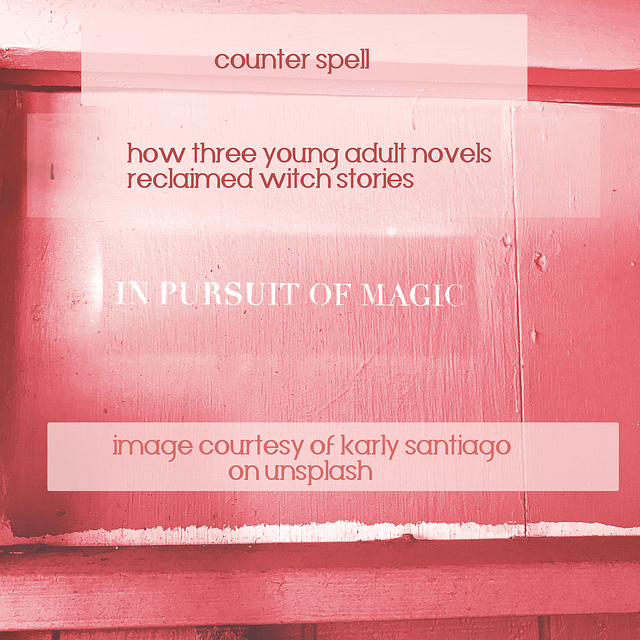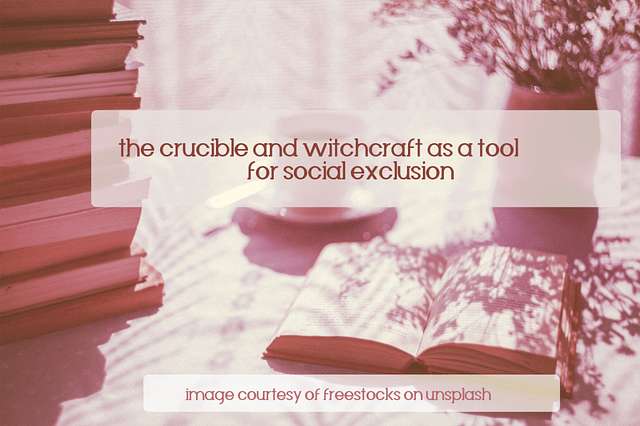
Witch Stories: An Introduction
Part of stories’ power lies in their ability to reflect the world back to readers. They can echo societal issues in compelling ways. This is especially the case with witches. I love witch stories because they often feature strong friendships in the face of an otherwise isolating society. Frequently, witch stories showcase an element of secrecy and isolation for the witches. In doing so, these tales are entwined with empowerment.
These witches are usually able to alter their surroundings through their connection to nature, to witches of the past, to each other, and themselves. Witches have always been captivating literary figures, especially in YA fiction. They have undergone several transformations throughout history. Witch stories have been loaded with anti-feminist undercurrents. However, in more recent books, witches have been reclaimed in young adult books and media as tools for empowering women. In this post, I will be uncovering some connections between witch stories, feminism, and some of my favorite YA fiction. Alakazam!
Witches and Societal Anxiety Around Women
What does a witch look like in literary history? Alastair Sooke mentions that witches sometimes looked like “strixes,” which are “frightening flying creatures that fed on the flesh of babies.” It is a perfect way of taking away what was once a maternal figure (Blomquist 2). Instead of being nurturing members of communities, witches now become a threat to the most helpless and innocent part of society. Not only does this villainize them, but it also pushes them further into the fringes of society.
This could put witches into solitary and secret spaces, however, sometimes they are presented as part of a trio. Paul Cornell tracks the history of a magic trio back to Macbeth’s weird sisters. These three witch figures prophesize Macbeth’s downfall from the play’s beginning. While they are the bearers of unpleasant news, they are also unsettling.
Witches in Shakespeare’s time were so furious with his portrayal of witchcraft that they cursed the play (Donaldson). Lest you think this is out of leftfield, Shakespeare’s portrayal of these witches is grim. After all their prophesies do lead Macbeth and his wife down a dark path.
To me, it reads more like a “chicken and the egg” type of question. Are the prophesies a reason for Macbeth’s downfall or was his downfall set in stone regardless of whether he knew what his future entailed? (This a topic for another day here, but I wanted to put it out there: is Lady Macbeth to blame for what Macbeth does? Or is this rooted in anti-feminism? Shouldn’t he have had his sense of morality and autonomy?).

The Crucible Evoking Witchcraft as a Tool of Social Expulsion
One of the most popular witch stories is that of The Crucible. It is a fictionalized Salem Witch trial. Written in the 1950s by Arthur Miller, the play follows four girls who accuse various people of witchcraft. It is one of the most blatantly anti-feminist takes on witchcraft. The four girls are questioned for dancing naked in the woods. Children are getting sick and tensions are high. Accusations are flying everywhere. At the core of all accusations is Abigail Williams. Abigail seeks vengeance from the Proctors, a couple she worked for. Abigail and John Proctor had an affair, thus fueling her vengeance.
Liane Carlson writes about witch hunts targeting marginalized women, with The Crucible acting as “a tragic story about how a wealthy male landowner is destroyed when his own unyielding principles collide with the vengeance of a lustful schoolgirl.” She points to the play’s misogyny. While the text blames Proctor’s downfall on women, he ultimately falls for his actions. After all, John Proctor’s treatment of his servant by “beating her and berating her.” (Carlson).
Witch Figures As Different Stages of Womanhood in The Cahill Witch Chronicles by Jessica Spotswood
Published in the early 2010s, this young adult trilogy follows three sisters: Cate, Maura, and Tess. As the oldest sister, Cate is aware of her surroundings and conducts herself accordingly. She is at the forefront of societal pressures when it comes to life choices. Does she want to be married? Or is she willing to forego that life for a more isolated lifestyle? Maura, on the hand, is wilder. She is charming, loud, and rebellious. Finally: Tessa, the balm between her two older sisters. She is the peacemaker.
Did you know that this is a common element of witch stories? There’s usually a group of three witches, each of whom manifests a different phase of womanhood: maiden, mother, and crone. Cate is the maternal figure in her family. She’s the leader and the protector of her siblings. Tessa is the crone, a mediating person whose goal is to make sure her other two sisters get along. Meanwhile, Maura is the maiden, bubbly and social, loving and passionate.
The sisters are witches in a time when The Brotherhood is persecuting witches. The Brotherhood, an institution aimed at limiting women’s power within this community, actively searches for anyone who could be a witch. In this trilogy, women have two paths: marry or join a group called the Sisterhood. This group appears to be a religious group: no romantic relationships are allowed. The rest is shrouded in mystery.
My favorite part of this trilogy is the relationship the main three sisters have with their history. They do not know their deceased mother’s background and as the story unfolds, we learn more about her. This is something that my favorite witch stories always explore. Either the main witches do not know their history or they are engrossed in it so much that they choose to honor it.
Plus, there’s the mystery aspect of the story. A prophecy. (I love a prophecy storyline).
<?php echo do_shortcode(‘
Feminism and Women’s Rights in Alix E. Harrows’ The Once and Future Witches
As a standalone, this book packs a punch like no other. The Once and Future Witches is loaded with history. Two types of histories show up in this book: the history of three sisters losing contact following various betrayals and a history of witches lost over time.
The story is set at a time when witching is illegal. Women do not have the right to vote. Both of these elements make The Once and Future Witches a YA fictional story with feminism taking center stage.
Again, here, there are three sisters with three very different personalities. Beatrice Belladonna is a lesbian (not out) librarian. She is quiet and reserved initially. She also brings the other two sisters into the story by revealing a magic tower. Agnes Amaranth is pregnant out of wedlock (a big no-no in the story’s setting). She is a factory worker. James Juniper is the youngest and most impulsive sister. She comes into the story as an on-the-run criminal who is intent on joining the women’s suffragist group. Suffragists in this particular story are focused on voting alone. With Juniper joining, however, she attempts to bring back witching, which leads to her expulsion.
Nevertheless, the coolest part of the story is how the characters still form a secret coven. Together, they attempt to bring witching back. It’s this sense of community that made this story so good. From a completely fragmented family to a cohesive community, the beauty of sisterhood expansion makes the book a joy to read.
Did you know that the archetype of the three witches can relate to moon phases? Paul Cornell writes that the number three could be “corresponding with the new, half, and full moon, and that there was another, always hidden, figure, the moon in the shadow.”
Paul Cornell. . “The Magic Number: Why Witches Come in Threes.” Tor.com. 20 Aug. 2015.
The Brooklyn Brujas series by Zoraida Cordova
Unlike the previous two book series, this one does not involve dead parents or a lack of awareness of the main character’s family history. In the first book of the trilogy, Labyrinth Lost, Alex knows what it takes to become a witch. However, she does not want to become one. Just a small hiccup here: she is the strongest witch in her family. While refusing her magic, she makes her whole family disappear. Naturally, her journey is about family and the impact of her refusal to become a witch.
The second book builds on the first one but follows a different sister, Lula. Lula’s story deals with her not accepting a person’s passing. She untangles herself from what she does to avoid grieving. You know, betraying the death goddess and raising a bunch of people from the dead. Basic things.
I have not read Rose’s story yet. But I do know that she’s quiet. Her story will involve a different expansion on how magic works in this universe. It will probably have something to do with her coming into her form of magic and identity.
Conclusion: Parting Words on Witch Stories in Young Adult Books
What is your experience with witch stories and/or feminism in young adult literature? Have you read any fairytales with a witch in them? I am curious to hear your thoughts, so drop them in the comment section. Have you read any of the books I mention in this post? Let’s talk witch stories, feminist reinterpretations of myth, and awesome books.
If you are looking for more book recommendations from me, check out my post on the Scythe trilogy here.
You must be logged in to post a comment.